近年来,入侵植物介导的生物入侵导致的环境生态问题日益凸显,特别是入侵植物可以显著影响本地生态系统的结构和功能,如明显改变本地群落组成、显著降低本地生物多样性等,因此,阐明入侵植物成功入侵的关键机理,乃当前入侵生态学领域倍受关注的重大前沿科学问题之一。
更为重要的是,一种入侵植物成功入侵后可通过影响微环境条件,进而利于其它入侵植物的成功入侵,从而形成两种甚至是两种以上入侵植物在同一生境共同入侵(也称入侵塌陷,或次生入侵,或入侵漩涡)。然而,多种入侵植物共同入侵可能对环境健康与生态安全造成新的、更严重的威胁。因此,亟待深入解析并进一步阐明多种入侵植物共同入侵的关键机理,特别是全景式对比分析多种入侵植物共同入侵下入侵植物和本地植物功能性状的相似性和差异性及其共存机理,并剖析多种入侵植物共同入侵对本地植物群落物种多样性和功能多样性、群落可入侵性以及土壤酶活性的影响,以进一步揭示其关键机理。
基于此,我所王从彦等人聚焦当前入侵生态学领域倍受关注的重大前沿科学问题之一,并独辟蹊径,重点解析三种均起源于美洲的菊科入侵植物共同入侵介导的入侵植物和本地植物共存机理及其环境生态效应与关键机理,具体以小飞蓬(Conyza canadensis (L.) Cronq.; 亦称加拿大蓬、加拿大飞蓬、小蓬草、小白酒草、小白酒菊)、苏门白酒草(C. sumatrensis (Retz.) Walker)和加拿大一枝黄花(Solidago canadensis L.)为研究材料,对比分析以上三种菊科入侵植物共同入侵下入侵植物与本地植物功能性状的相似性和差异性及其共存机理,并进一步解析不同入侵类型(即:一种入侵植物的单一入侵、两种入侵植物的共同入侵以及三种入侵植物的共同入侵)下入侵植物对本地植物群落物种多样性和功能多样性、群落可入侵性以及土壤酶活性的影响和差异及其关键机理,从而进一步阐明多种入侵植物共同入侵的关键机理。
本研究的主要结论具体如下:
1. 三种菊科入侵植物共同入侵下入侵植物与本地植物功能性状的相似性和差异性及其共存机理
(1)在所有入侵类型下,三种入侵植物小飞蓬、苏门白酒草和加拿大一枝黄花与本地植物功能性状存在明显的差异性,特别是在所有入侵类型下三种入侵植物小飞蓬、苏门白酒草和加拿大一枝黄花的株高均显著高于本地植物的株高。
(2)在所有入侵类型下,三种入侵植物小飞蓬、苏门白酒草和加拿大一枝黄花与本地植物的共存主要是生态位分化起主导作用,而非生境过滤。
(3)三种入侵植物小飞蓬、苏门白酒草和加拿大一枝黄花的成功入侵,不管是单一入侵,还是两种入侵植物共同入侵,亦或是三种入侵植物共同入侵,其竞争优势可能主要取决于其获取阳光能力的高低,而非取决于其叶片光合面积的大小和光合能力的强弱。
2. 三种菊科入侵植物共同入侵对本地植物群落物种多样性和功能多样性以及可入侵性的影响及其关键机理
(1)三种入侵植物小飞蓬、苏门白酒草和加拿大一枝黄花的入侵,不管是单一入侵,还是两种入侵植物共同入侵,亦或是三种入侵植物共同入侵,均在一定程度上增加了本地植物群落物种多样性和功能多样性。且不同入侵类型对本地植物群落物种多样性和功能多样性产生正面影响的强度大小均依次为:三种入侵植物共同入侵 > 两种入侵植物共同入侵 > 一种入侵植物单一入侵。因此,共同入侵的三种入侵植物对本地植物群落物种多样性和功能多样性的影响均存在一定程度的叠加效应。
(2)入侵植物相对丰度与本地植物群落株高的加权平均数指数、根据所测功能性状平均值计算的加权平均数指数、株高的Rao’S二次熵指数和根据所测功能性状平均值计算的Rao’S二次熵指数显著正相关。
(3)入侵植物的种类数量与本地植物群落Shannon’s多样性指数、Simpson’s优势度指数、Margalef’s丰富度指数、株高的Rao’S二次熵指数、叶片叶绿素含量和叶片氮含量的Rao’S二次熵指数以及根据所测功能性状平均值计算的Rao’S二次熵指数极显著正相关。
(4)与本地植物群落物种多样性相比,本地植物群落可入侵性主要取决于其功能多样性,具体为:本地植物群落可入侵性主要受本地植物群落株高的加权平均数指数、根据所测功能性状平均值计算的加权平均数指数以及株高的Rao’S二次熵指数和根据所测功能性状平均值计算的Rao’S二次熵指数之影响。因此,基于不同功能性状的本地植物群落功能多样性对其可入侵性的影响力可能存在明显差异,且基于株高的本地植物群落功能多样性对其可入侵性的影响力最强。
Table 1 Differences in the total relative abundance of these three invasive alien species and plant taxonomic diversity under seven invasion combinations and the uninvaded controls.
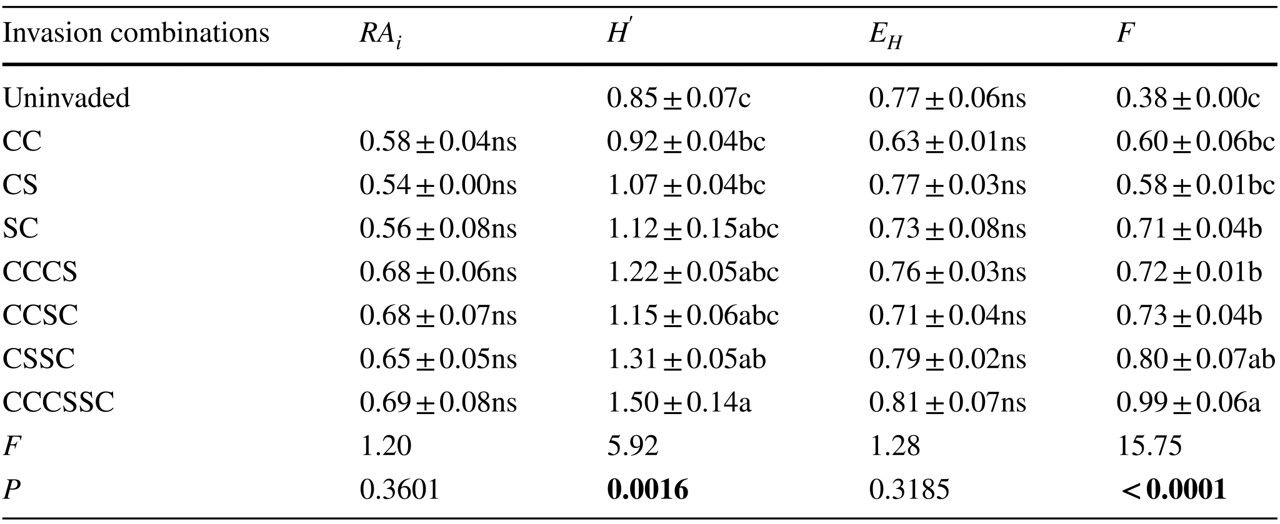
Data (mean with standard error, n = 3) with different lowercase letters in a vertical column indicate statistically significant differences (P < 0.05). “ns” indicates no statistically significant difference (P > 0.05). P values equal to or lower than 0.05 are shown in bold. Abbreviations: CC, invasion by C. canadensis; CS, invasion by C. sumatrensis; SC, invasion by S. canadensis; CCCS, co-invasion by C. canadensis and C. sumatrensis; CCSC, co-invasion by C. canadensis and S. canadensis; CSSC, co-invasion by C. sumatrensis and S. canadensis; CCCSSC, co-invasion by C. canadensis, C. sumatrensis, and S. canadensis; RAi, the total relative abundance of these three invasive alien species; H’, Shannon’s diversity index; EH, Pielou’s evenness index; F, Margalef’s richness index.
Table 2 Correlations (r) between the total relative abundance of these three invasive alien species, and plant taxonomic and functional diversity under seven invasion combinations (n = 21).
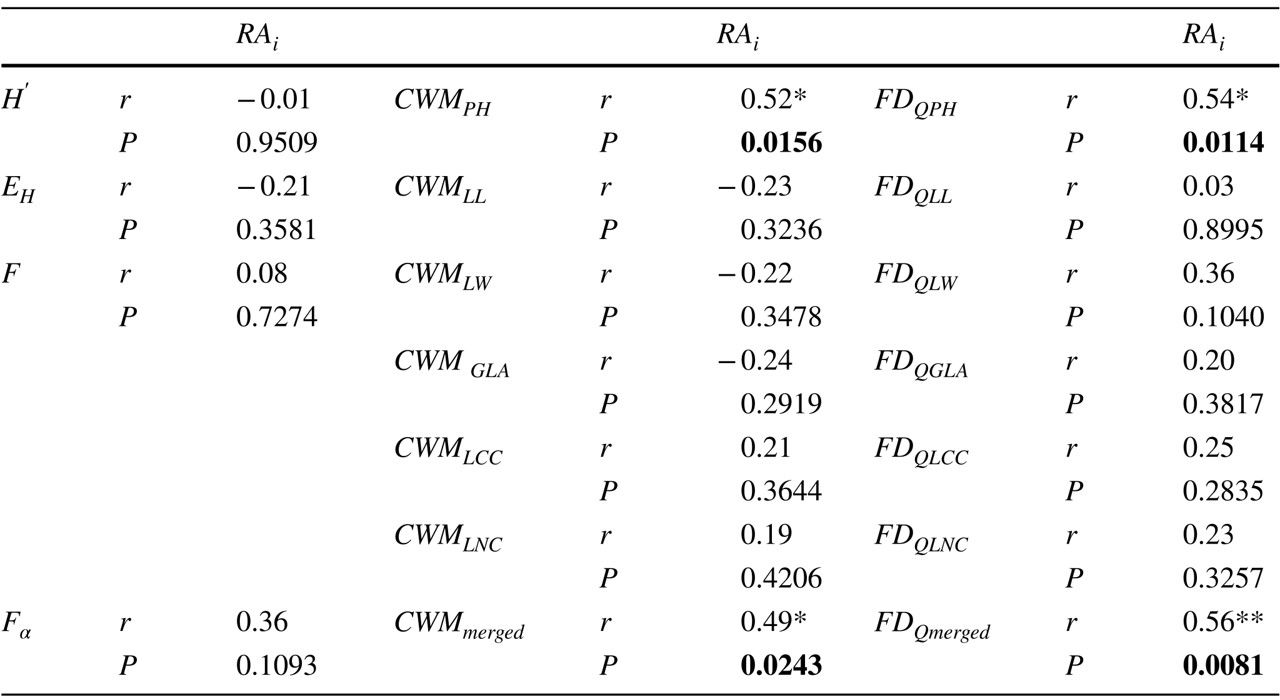
* indicates statistically significant differences at the 0.05 probability level. P ≤ 0.05 are shown in bold. Abbreviations: RAi, the total relative abundance of these three invasive alien species; H’, Shannon’s diversity index; EH, Pielou’s evenness index; F, Margalef’s richness index; CWMPH, CWM of plant height; CWMLL, CWM of leaf length; CWMLW, CWM of leaf width; CWMGLA, CWM of green leaf area; CWMLCC, CWM of leaf chlorophyll concentration; CWMLNC, CWM of leaf nitrogen concentration; CWMmerged, the merged CWM trait value calculated as the mean of the measured traits; FDQ PH, FDQ of plant height; FDQ LL, FDQ of leaf length; FDQ LW, FDQ of leaf width; FDQ GLA, FDQ of green leaf area; FDQ LCC, FDQ of leaf chlorophyll content; FDQ LNC, FDQ of leaf nitrogen content; FDQ merged, the merged FDQ calculated as the mean of the measured traits.
Table 3 Correlations (r) between the number of invasive alien species (Si), and plant taxonomic and functional diversity across all study plots (n = 21).
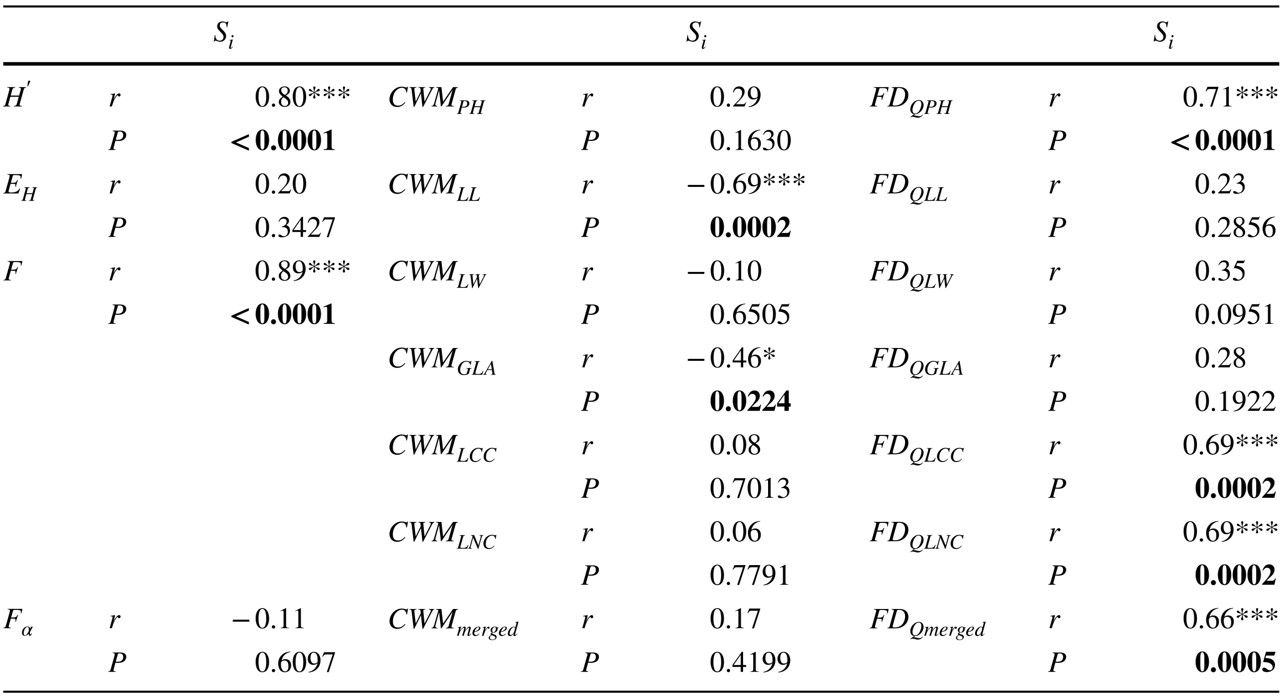
* and *** indicate statistically significant differences at the 0.05 and 0.001 probability levels, respectively. P ≤ 0.05 are shown in bold. Abbreviations: RAi, the total relative abundance of these three invasive alien species; H’, Shannon’s diversity index; EH, Pielou’s evenness index; F, Margalef’s richness index; CWMPH, CWM of plant height; CWMLL, CWM of leaf length; CWMLW, CWM of leaf width; CWMGLA, CWM of green leaf area; CWMLCC, CWM of leaf chlorophyll concentration; CWMLNC, CWM of leaf nitrogen concentration; CWMmerged, the merged CWM trait value calculated as the mean of the measured traits; FDQ PH, FDQ of plant height; FDQ LL, FDQ of leaf length; FDQ LW, FDQ of leaf width; FDQ GLA, FDQ of green leaf area; FDQ LCC, FDQ of leaf chlorophyll content; FDQ LNC, FDQ of leaf nitrogen content; FDQ merged, the merged FDQ calculated as the mean of the measured traits.
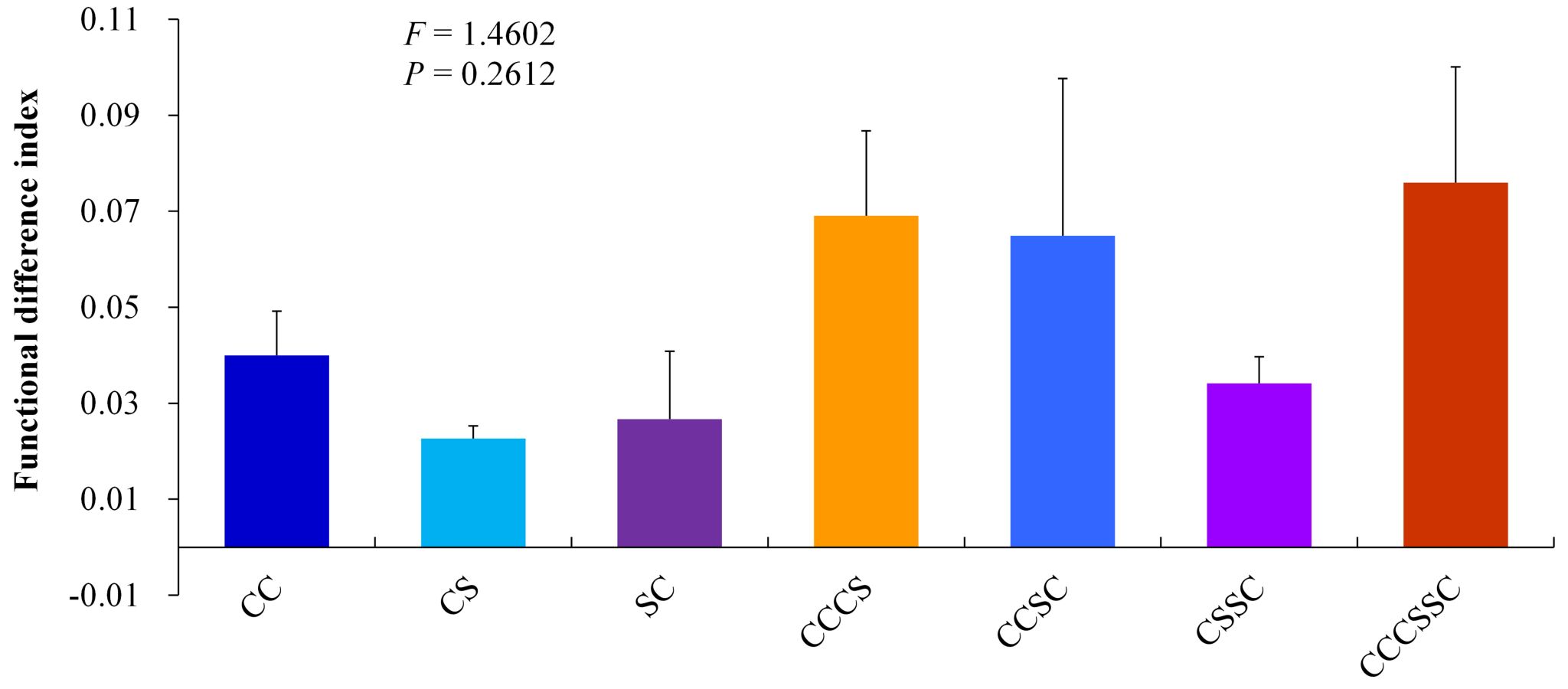
Fig. 1 Functional difference index between these three invasive alien species and natives under seven invasion combinations. Bars (mean with standard error, n = 3) with “ns” indicate no statistically significant difference (P > 0.05). Note: these three invasive alien species and natives tend to show functional divergence when the value of this index is > 0 but tend to show functional convergence when the value of this index is < 0. Abbreviations: CC, invasion by C. canadensis; CS, invasion by C. sumatrensis; SC, invasion by S. canadensis; CCCS, co-invasion by C. canadensis and C. sumatrensis; CCSC, co-invasion by C. canadensis and S. canadensis; CSSC, co-invasion by C. sumatrensis and S. canadensis; CCCSSC, co-invasion by C. canadensis, C. sumatrensis, and S. canadensis.
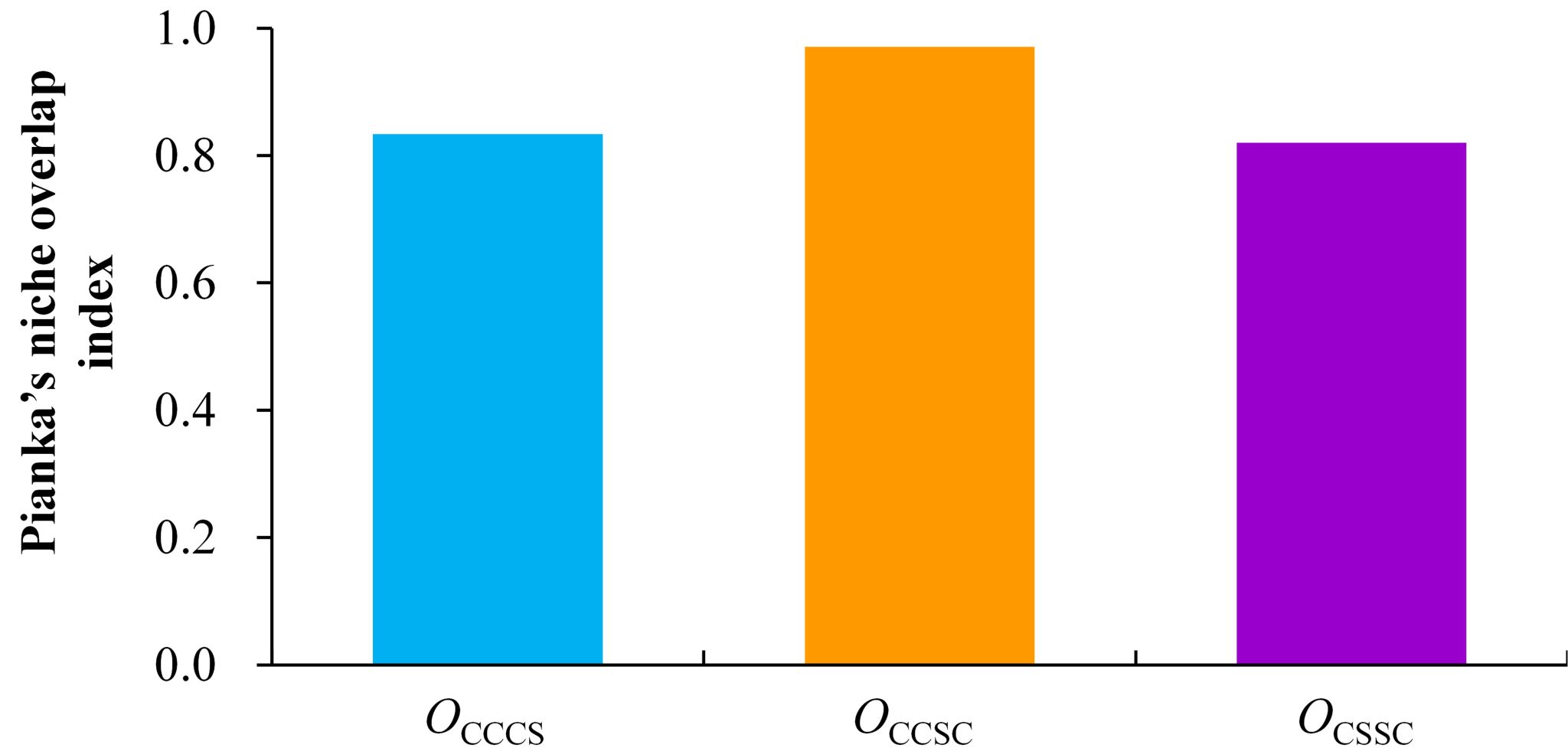
Fig. 2 Differences in the Pianka’s niche overlap index under co-invasion by these three invasive alien species. Abbreviations: OCCCS, the Pianka’s niche overlap index between C. canadensis and C. sumatrensis; OCCSC, the Pianka’s niche overlap index between C. canadensis and S. canadensis; OCSSC, the Pianka’s niche overlap index between C. sumatrensis and S. canadensis.
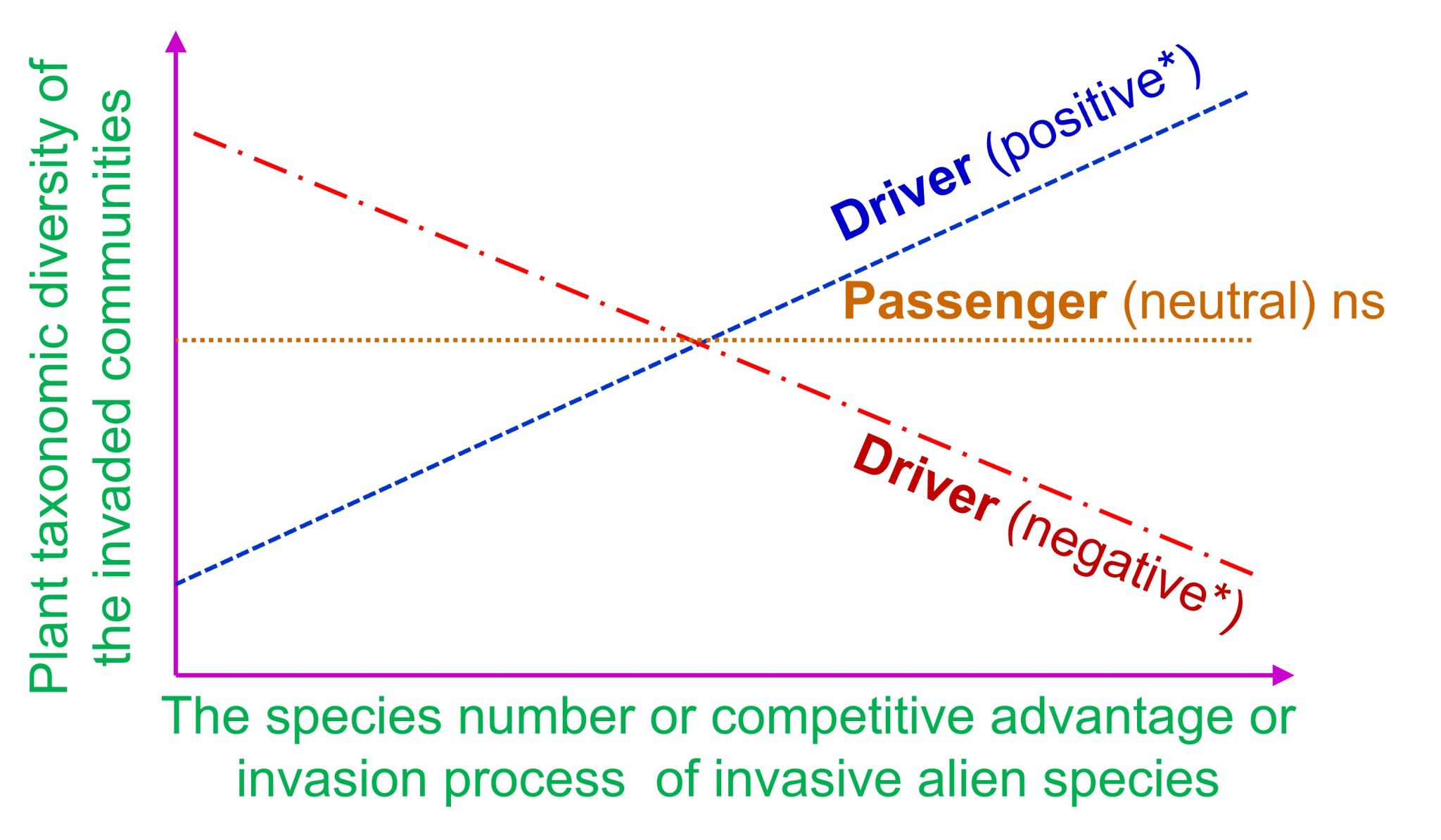
Fig. 3 The schematic diagram of the Passenger-Driver Hypothesis [the drivers of changes: triggered distinct shifts in plant taxonomic diversity (including positive and negative effects of invasive alien species on plant taxonomic diversity); the passengers of changes: shifts in plant taxonomic diversity mediated by other factors (i.e., neutral effects of invasive alien species on plant taxonomic diversity)]. * indicates statistically significant differences (P < 0.05). “ns” indicates no statistically significant difference (P > 0.05).
研究结果对阐明多种入侵植物共同入侵的关键机理,特别是多种入侵植物共同入侵下入侵植物和本地植物的共存机理以及入侵植物的环境生态效应和环境进化响应机理奠定了强有力的理论支撑。
全文链接:https://doi.org/10.1007/s42977-024-00202-w






